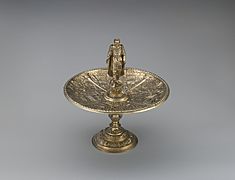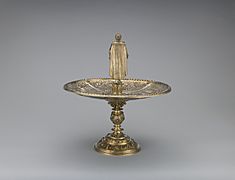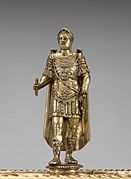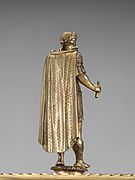Aldobrandini Tazze facts for kids
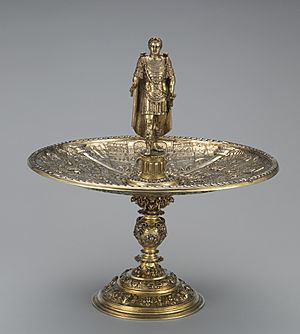
The Aldobrandini Tazze are a special collection of 12 fancy cups or bowls. They are made of silver covered in a thin layer of gold, which makes them look very shiny and valuable. These cups are shaped like shallow bowls on tall stands, and they are considered some of the most amazing examples of metalwork from the Renaissance period (a time of great art and learning in Europe).
Each tazza (that's the Italian word for one of these cups) has a shallow bowl on a tall foot and stem. In the middle of each bowl, there's a small statue of one of the first Roman emperors. These emperors' lives were written about by a Roman author named Suetonius in his book, The Twelve Caesars. Inside each bowl, you can see four detailed pictures. These pictures are made by carefully shaping the metal and show important moments from that emperor's life.
The history of these tazze is a bit of a mystery! For a long time, people thought a famous artist named Benvenuto Cellini made them, but that's not believed anymore. Experts now think they were made in the southern Netherlands around the late 1500s. They might have been made for a powerful family called the House of Habsburg. Later, they were bought by the Aldobrandini family, which is how they got their name. Since each cup looks a little different, it's likely that a team of skilled silversmiths worked on them.
The cups stayed together in one collection until about 1861. Originally, they were just silver, but they were covered in gold sometime after 1861. Over time, the set was split up, and now the cups are in different museums and private collections around the world. It's also interesting that some parts got mixed up! A bowl showing scenes from one emperor's life might now have the statue of a different emperor on it.
In 2014, all 12 tazze were brought back together at the Metropolitan Museum of Art in New York City. This was for a big research project and then an exhibition called The Silver Caesars: A Renaissance Mystery. This was the first time they had been shown together in public since the mid-1800s! After New York, the exhibition traveled to Waddesdon Manor in England in 2018.
Contents
What Are the Aldobrandini Tazze?
Each tazza is a cup or bowl, about 16 inches (41 cm) tall. Their shape comes from an ancient Greek wine cup called a kylix. While some tazze could be used for drinking, they were probably mostly used as fancy serving dishes for small treats like sweets or fruit. These beautifully decorated cups were mainly meant to show off how rich and artistic their owners were.
Each tazza is made of seven main parts that screw together:
- A base with a foot and stem.
- A hidden disc that holds the bowl.
- The round, dish-like bowl itself.
- A small stand in the center of the bowl.
- The statue of a Roman emperor on top of the stand, with a separate cape.
Decorations on the Bowls
The inside of each shallow bowl is decorated with detailed patterns. There are classical columns that divide the space into four sections. Each section shows a scene from the life of a specific Roman emperor. The 12 emperors featured are:
- Julius Caesar
- Augustus
- Tiberius
- Caligula
- Claudius
- Nero
- Galba
- Otho
- Vitellius
- Vespasian
- Titus
- Domitian
Many bowls also have the Aldobrandini family's coat of arms. This includes a special hat with six tassels on each side, which shows that a bishop owned them. Since these marks are often on the underside of the bowls, it suggests the Aldobrandini family bought the set later, rather than having it made for them.
Who Made These Amazing Cups?
The silver tazze were made around 1560–1570. We don't know who designed or made them. Because the decorations on the bowls are all a bit different, it seems that several skilled artists worked on them. Some of the bowl designs might have been inspired by the Italian artist Pirro Ligorio. The emperor statues might be based on drawings by the Flemish artist Johannes Stradanus.
Over time, some of the original bases (the foot and stem) were replaced. The original bases were simple and classic. Six of them were swapped for more decorated bases from the same time period, possibly from Spanish religious objects called monstrances or reliquaries.
The Early History of the Tazze
The exact early history of the tazze isn't fully known. We know they were listed in an inventory (a detailed list of possessions) belonging to Cardinal Pietro Aldobrandini in 1603. It's possible they belonged to Pope Clement VIII (who was named Ippolito Aldobrandini the Elder before he became Pope). If the six tassels on the family arms are accurate, it means he got the tazze before 1585, when he became a cardinal. However, other family members who were also Catholic leaders might have added the marks later.
Another idea is that Archduke Albert VII of Austria gave them to Cardinal Pietro Aldobrandini. The Aldobrandini family hosted the Archduke in 1598 during a special visit.
The complete set then seems to have gone to Cardinal Ippolito Aldobrandini the Younger. They were listed in his inventory after he died in 1638. The tazze were passed down through the family for many years. They were still owned by the Borghese branch of the family in 1769. They might have stayed in Italy until around 1798, when Napoleon's army took over Rome.
The Tazze from the 1800s Onward
The set of 12 tazze might have been taken to London in the early 1800s. By 1826, they were owned by a silver dealer named Kensington Lewis. People thought they were made by Benvenuto Cellini at this time. The set was sold in London in 1834 for 1,000 guineas (an old type of British coin).
They were then bought by Charles Scarisbrick. After he died, they were sold again in 1861. It was sometime after this sale that the silver cups were covered in gold. Before this, old lists and descriptions only mentioned them as being silver.
A set of copies of the 12 emperor statues was made when the collection was still complete. These copies were later sold in 1976.
A dealer from Paris named Frédéric Spitzer later bought the tazze. He sold six of them to different collectors, with many going to members of the wealthy Rothschild family. The other six tazze stayed with Spitzer until he died in 1893.
During this time, some of the bowls and emperor statues got mixed up. Spitzer also replaced the simple original bases with more decorative ones. These new bases might have come from old Spanish religious objects. This was likely done to make the tazze look more appealing and sell for a higher price.
Recent Discoveries About the Tazze
In recent years, researchers like Yvonne Hackenbroch, John Hayward, and David Revere McFadden have helped to figure out more about the tazze's history. In 1976, some parts were still missing, like the bowl and statue of Tiberius, the Claudius statue and bowl, the Nero bowl, and the Galba statue. Since then, the locations of these missing pieces have been found. For example, the complete Claudius tazza is in a private collection, and the Galba statue is in Lisbon.
All the known parts of the 12 tazze were brought together at the Metropolitan Museum of Art in 2014. They were displayed in an exhibition from December 2017 to March 2018. For the exhibition, the cups were put back together correctly, with each emperor statue matched with its own bowl. They were then taken apart to be shipped to Waddesdon Manor for another exhibition. After the exhibitions, the plan is to return them to their owners in their mixed-up state, but there are talks to try and fix the mismatches permanently.
Only one tazza, the one for Claudius, is still in its original form. It has its original simple base, and the Claudius bowl is still with the Claudius statue. Five others have their original bases, but their bowls and statues are mixed up. For example, the Galba bowl is with the Caligula statue, and the Caligula bowl is with the Galba statue. Four other tazze (Julius Caesar, Otho, Vitellius, and Vespasian) have matching bowls and statues but have the replaced, decorated bases. The Titus bowl is missing both its statue and its base.
The 12 Tazze and Where They Are Now
Here's where you can find the different parts of the Aldobrandini Tazze today:
- Julius Caesar
- The Julius Caesar tazza (bowl and statue, but with a replaced decorated base) is at the Museo Lázaro Galdiano in Madrid, Spain.
- Augustus
- The bowl of the Augustus tazza (with its original simple base, but now with the statue of Nero) was sold in 2000 and is now in the collection of Selim Zilkha.
- The Augustus statue (now with the bowl of the Domitian tazza) is at the Minneapolis Institute of Art.
- Tiberius
- The bowl of the Tiberius tazza (with its original simple base, but now with the statue of Domitian) is at the Victoria and Albert Museum in London.
- The Tiberius statue (now with the bowl of the Nero tazza) is in a private collection, on loan to the Metropolitan Museum of Art.
- Caligula
- The bowl of the Caligula tazza (with its original simple base, but now with the statue of Galba) is at the Museu António Medeiros e Almeida in Lisbon, Portugal.
- The Caligula statue (now with the bowl of the Galba tazza) is in the Bruno Schroder collection in the United Kingdom.
- Claudius
- The Claudius tazza (bowl and statue, with its original simple base) is in a private collection, on loan to the Metropolitan Museum of Art, New York. This is the only one still in its original setup!
- Nero
- The bowl of the Nero tazza (with its original simple base, now with the statue of Tiberius) is in a private collection, on loan to the Metropolitan Museum of Art.
- The statue of Nero (now with the bowl of the Augustus tazza) is in the collection of Selim Zilkha.
- Galba
- The bowl of the Galba tazza (with its original simple base, now with the statue of Caligula) is in the Bruno Schroder collection in the United Kingdom.
- The Galba statue (now with the Caligula bowl) is at the Museu António Medeiros e Almeida in Lisbon.
- Otho
- The Otho tazza (bowl and statue, but with a replaced decorated base) is in the Lee Collection at the Royal Ontario Museum in Toronto, Canada.
- Vitellius
- The Vitellius tazza (bowl and statue, but with a replaced decorated base) is at the Metropolitan Museum of Art in New York.
- Vespasian
- The Vespasian tazza (bowl and statue, but with a replaced decorated base) is in the private Al Thani collection in London.
- Titus
- The bowl of the Titus tazza is at the Museu Nacional de Arte Antiga in Lisbon. The original base and statue are now lost.
- There is also a copy of the Titus tazza bowl from the 1800s (with a replaced decorated base and a copy of the Julius Caesar statue). This copy is now in a private collection.
- Domitian
- The bowl of the Domitian tazza (with a copy of its original simple base, now with the statue of Augustus) is at the Minneapolis Institute of Art.
- The Domitian statue is at the Victoria and Albert Museum, now with a bowl that was once thought to be Domitian's but is now believed to be Tiberius'.
- Images of the Vitellius ''tazza''


